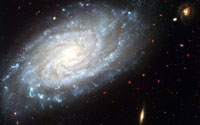Universe may burn out and die if it continues expanding
For a long while, politicians have shown some interest in the universe only when they discussed finalists of the Miss Universe beauty contests. But things have apparently changed. These days the U.S. president links up his ambitions with the deep space exploration program. Recently the Russian president recommended that space research be treated as an area of strategic importance. Vladimir Putin sounded quite knowledgeable when speaking about astrophysics at a State Council meeting. He announced that the Sun would fade to black in several billion years. The announcement is sad but true. The Sun is doomed to burn out no matter how hard politicians may strive to hold back the event. According to information obtained by Izvestia, President Putin took a private course of lectures on cosmology, the Big Bang theory, and history of the universe. Why should a politician be interested in a subject that seems completely irrelevant to earthly matters?

The universe comprises hundreds of billions of galaxies. Each galaxy contains tens of billions of stars. Alexander Friedmann, a Russian and Soviet cosmologist and mathematician, came up with a theory that is believed to describe the state of the universe in the full. Friedmann had the nerve to correct Albert Einstein’s theory of general relativity. Friedmann’s equations show that the universe might be expanding in contrast to Einstein’s advocated state-steady universe model. The questions are: How did the universe originate? Will the universe continue to expand? Will it finally cease to exist and put an end to the course of time?
According to the Big Bang theory, the universe emerged from an extremely hot and dense state about 14 billion years ago. Though the idea may defy imagination, nothing had existed until the Big Bang occurred. Time did not exist. Having been compressed into nothingness, the universe expanded from a state in which all the matter and energy was at an immense temperature and density. For reasons unknown, the Big Bang took place, transforming energy into light and matter. We can still see the light that came into being one millionth fraction of a second after the Big Bang. The light is relic radiation or cosmic microwave background radiation. The Hubble Space Telescope, the most advanced instrument in history of science, is capable of peering deep into the past that stretches back to 12 billion years.
The temperature of radiation dropped as the universe continued growing in size. There were numerous transition phases in history of the universe. Unlike periods in history of Earth, those phases e.g. the andron and lepton eras, the hot and cold baryosynthesis epoch, the nucleosynthesis epoch, the radiation and recombination epochs – lasted mere fractions of a second. The temperaturedropped to 10 thousand million degrees one second after the Big Bang. The temperature dropped to one thousand million degrees one hundred seconds later, equaling that of the stars. Quarks and gluons begin to combine into baryons such as protons and neutrons at such a temperature. However, the first nuclei of hydrogen and helium formed only three minutes after the Big Bang. The formation of the nuclei took several hours to complete, and the universe expanded for hundreds of millions of years thereafter. Another billion years passed until the first star took shape. The above times are dubbed “dark ages” in cosmology.
The planet Earth is located in a galaxy called the Milky Way. The light takes 2 million years to reach Andromeda galaxy, the closest neighbor to our own galaxy. We are falling apart at a speed of 1.5 million kilometers per hour – the speed seems rather low compared to a 1 billion-per-hour expansion speed at the fringes of the universe. The Sun is a relatively small star in the boondocks of the universe. The Sun is 10 times smaller and 20 times cooler than the first-degree stars.
The universe will cool off and expire if it goes on expanding. Our Sun will go out, and the stars will turn into a tepid and watery soup. Billions of galaxies will be eventually sucked in by black holes. Is there any elixir that is able to prolong the life of the universe?
Getting an answer to the question is a hell of a job since only 5% of the matter that makes up the universe is the so-called regular matter i.e. the one on which reliable scientific information is available. The remaining compositional elements are still a mystery. Roughly ninety-five percent of the universe is in the exotic forms of dark matter and dark energy. According to estimates, some 25% of the universe is composed of dark matter. The universe is thought to be nearly flat in terms of spatial proportions as indicated by measurements of the cosmic microwave background radiation, and about 70% of the energy density of the universe remains unaccounted for.
The mystery appears to be connected with yet another mystery relating to the expansion of the universe, which is thought to be undergoing a non-linear acceleration. In order to explain the acceleration, the general relativity theory requires that an energy component with intense negative pressure make up a larger part of the universe. The dark energy is now thought to make up the missing 70% of the proportional composition of the universe. Along with dark matter, dark energy remains one of the great mysteries of the Big Bang. Several projects aimed to detect dark matter particles and explain dark energy are currently under way.
Izvestia Nauki
Translated by Guerman Grachev
Pravda.ru
Subscribe to Pravda.Ru Telegram channel, Facebook, RSS!


